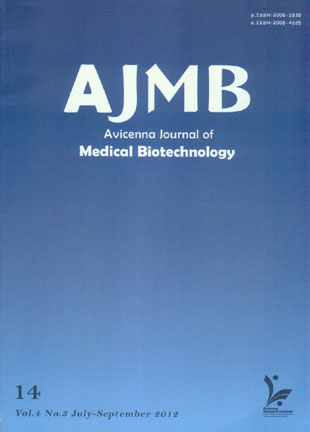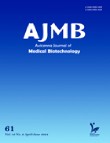فهرست مطالب

Avicenna Journal of Medical Biotechnology
Volume:4 Issue: 3, Jul-Sep2012
- 58 صفحه،
- تاریخ انتشار: 1391/05/20
- تعداد عناوین: 7
-
-
Page 112
-
Page 114Growing usage of animals in the research projects has drawn more attention to their welfare and ethics surrounding this practice. Dissemination of information about the existing ethical consideration and alternatives in animal experiments has two important functions; first, it increases the researcher''s awareness of the possible methods of using animals in the experiment, and second, to ensure that potential users are aware of the established alternatives. For example, legislations enacted in many countries during the 1980s state that laboratory animal applications should be reduced, refined and replaced wherever possible according to principles of the 3Rs. Thus, scientists around the world tried to apply the 3Rs in their biomedical researches regarding welfare of the laboratory animals. However, the Qur’an, the holy book of Muslims, and also Hadiths contain the obligatory ways to keep and treat animals since their revelations. According to Islamic viewpoint, animals represent Allah''s ability and wisdom, and humans must pay attention to their health and living conditions. Several Islamic manuscripts state that animals have their own position in the creation hierarchy and humans are responsible for supplying minimal facilities and their welfare. This paper has tried to review ethical consideration in animal experiments and regarding Islamic resources in this case to encourage providing comprehensive ethical regulations in animal experiments which its establishment could be beneficial for animal ethics committees or research institutes.Keywords: Animals, Ethics, Research, Welfare
-
Page 121BackgroundThioredoxin reductase 1 (TXNRD1) and thioredoxin interacting protein (TXNIP) also known as thioredoxin binding protein 2 or vitamin D3-upregulated protein 1 are key players in oxidative stress control. Thioredoxin (TRX) is one of the major components of the thiol reducing system and plays multiple roles in cellular processes. Computational analyses of TXNRD1, TXNIP and TRX expressions have not been analyzed in relation to prognosis of breast cancer. High expression of TXNRD1 and low expression of TXNIP are associated with worst prognosis in breast cancer.MethodsUsing bioinformatics applications we studied sequence analysis, molecular modeling, template and fold recognition, docking and scoring of thioredoxin as a target.ResultsThe resultant model obtained was validated based on the templates from I-TASSER server and binding site residues were predicted. The predicted model was used for Threading and Fold recognition and was optimized using GROMACS. The generated model was validated using programs such as Procheck, Ramachandran plot, verify-3d and Errat value from Saves server, and the results show that the model is reliable. Next we obtained small molecules from pubchem and chembank which are databases for selecting suitable ligands for our modeled target. These molecules were screened for docking, using GOLD and scoring was obtained using Chemscore as a scoring function.ConclusionThis study predicted the ligand interaction of four molecules with the minimized protein modeled structure and the best ligand with top scores from about 500 molecules screened. These were 3-hydroxy-2,3-diphenylbutanoic acid, 4-amino-3-pentadecylphenol, 3-(hydroxyimino)-2,4-diphenylbutanenitrile and 2-ethyl-1,2-diphenylbutyl carbamate, which are proposed as possible hit molecules for the drug discovery and development process.Keywords: Breast cancer, Chemotherapy, Sequence analysis, Thioredoxins
-
Page 131BackgroundBecause of the lack of an effective and economical control strategy against malaria (the most devastating infectious disease in developing countries) Transmission-Blocking Vaccines (TBVs) concept has been raised in recent years, promising a more efficient way to malaria control. TBVs aim at interfering and/or blocking pathogen development within the vector, halting transmission to non-infected vertebrate host. Aminopeptidase N (APN) is one of the most potent proteins in parasite development in Anopheles malaria vectors, which is strongly co-localized with human malaria parasites in the mosquito midgut epithelium. Therefore, Aminopeptidase N is one of the best choices for a new TBV.MethodsIn this study for the first time we used 3''-RACE to amplify APN gene in Anopheles stephensi (An.stephensi), a major malaria vector in Iran, Indian subcontinent up to China by using different sets of primers including exon junction, conserved and specific region primers.ResultsFull length of APN was sequenced stepwise, which could be applied in designing a new regional TBV and act as an essential component of malaria elimination program in An. stephensi distribution areas.ConclusionPrimers design and method modification should be set up exactly in approach based amplifications. From results we came to this conclusion that that 3''-RACE could be applied to amplified key regions which are be-yond reach.Keywords: 3', RACE, Anopheles stephensi, APN, Aminopeptidase N, Malaria, Transmission blocking vaccine
-
Page 142BackgroundStreptokinase is a potent activator of plasminogen to plasmin, the enzyme that can solubilize the fibrin network in blood clots. Streptokinase is currently used in clinical medicine as a thrombolytic agent. It is naturally secreted by β-hemolytic streptococci.MethodsTo reach an efficient method of purification, an immunoaffinity chromatography method was developed that could purify the streptokinase in a single step with high yield. At the first stage, a CNBr-Ac-tivated sepharose 4B-Lysine column was made to purify the human blood plasminogen. The purified plasminogen was utilized to construct a column that could purify the streptokinase. The rabbit was immunized with the purified streptokinase and the anti-streptokinase (IgG) purified on another streptokinase substituted sepharose-4B column. The immunoaffinity column was developed by coupling the purified anti-Streptokinase (IgG) to sepharose 6MB–Protein A. The Escherichia coli (E.coli) BL21 (DE3) pLysS strain was transformed by the recombinant construct (cloned streptokinase gene in pGEX-4T-2 vector) and gene expression was induced by IPTG. The expressed protein was purified by immunoaffinity chromatography in a single step.ResultsThe immunoaffinity column could purify the recombinant fusion GST-SK to homogeneity. The purity of streptokinase was confirmed by SDS-PAGE as a single band of about 71 kD and its biological activity determined in a specific streptokinase assay. The yield of the purification was about 94%.ConclusionThis method of streptokinase purification is superior to the previous conventional methods.Keywords: Chromatography, Purification, Streptokinase, Thrombolytic agent
-
Page 148BackgroundIn this study, we evaluated the protective effects of water Hyacinth Root Powder (HRP) on arsenic-mediated toxic effects in mice.MethodsSwiss albino mice, used in this study, were divided into four different groups (for each group n=5). The control group was supplied with normal feed and water, Arsenic group (As-group) was supplied with normal feed plus arsenic (sodium arsenite)-containing water, and arsenic+hyacinth group (As+Hy group) was supplied with feed supplemented with HRP plus arsenic water. The remaining Hy-group was supplied with feed supplemented with HRP plus normal water.ResultsOral administration of arsenic reduced the normal growth of the mice as evidenced by weight loss. Interestingly, tip of the tails of these mice developed wound that caused gradual reduction of the tail length. Supplementation of HRP in feed significantly prevented mice growth retardation and tail wounding in As+Hy group mice. However, the growth pattern in Hygroup mice was observed to be almost similar to that of the control group indicating that HRP itself has no toxic or negative effect in mice. Ingested arsenic also distorted the shape of the blood cells and elevated the serum enzymes such as lactate dehydrogenase (LDH), alkaline phosphatase (ALP) and serum glutamic pyruvic transaminase (SGPT). Importantly, elevation of these enzymes and distortion of blood cell shape were partially reduced in mice belong to As+Hy group, indicating HRP-mediated reduction of arsenic toxicity.ConclusionTherefore, the preventive effect of hyacinth root on arsenic-poisoned mice suggested the future application of hyacinth to reduce arsenic toxicity in animal and human.Keywords: Arsenic, Blood cell morphology, Growth retardation, Mice, Water hyacinth
-
Page 155BackgroundEpilepsy is a chief communal health problem. Antiepileptic drugs only provide symptomatic treatment. Walnut Kernels (WK) have high concentrations of phenolic compounds, which have beneficial effects on human health because of their antioxidant and anti-atherogenic properties. The present study was designed to evaluate the efficacy of WK supplementation for the prevention of experimental epilepsy in male rats.MethodsWistar adult male rats were divided into three groups: a control group (PTZ injection, fed with ordinary food), experimental group (PTZ injection, fed with WK) and a sham group (no PTZ injection, only for histological studies). Pentylenetetrazole (PTZ) was administered after the prescribed time.ResultsWKs displayed anti-epileptogenic properties, and WK supplementation was associated with increased seizure threshold and reduced mortality in the experimental group versus controls.ConclusionUse of WK may be helpful in prevention of PTZ-induced seizure and its further neurodegeneration in male rats.Keywords: Antioxidants, Neuroprotective, Rat, Seizures


